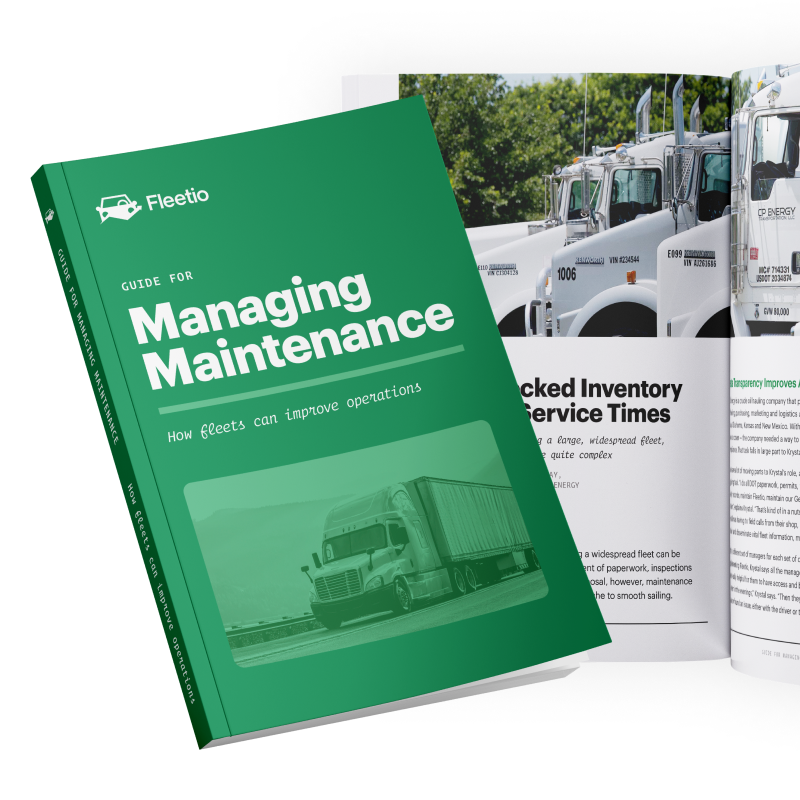3 Takeaways from Our Episode of "Straight Talk on Fleet"
While the importance of fleet maintenance is universally accepted, many fleets struggle to keep up with the needs of their vehicles and equipment. But by approaching maintenance with the right mindset, fleets can achieve their desired outcomes.
Jul 8, 2025
4 min read

Content Overview
This blog post recaps the episode of IntelliShift’s “Straight Talk on Fleet” podcast where Fleetio’s Stefano Daneri highlighted the importance of fleets being proactive in their maintenance approach. It emphasizes how maintenance impacts safety, reputation, and culture, urging fleets to adopt long-term strategies and invest in their teams.
Fleetio's Fleet Ecosystem Strategist Stefano Daneri recently guested on IntelliShift’s “Straight Talk on Fleet” podcast. During the episode, Stefano discussed various ways fleets can step up their maintenance operations with host (and fleet evangelist) Erin Gilchrist.
We highly encourage you to listen to the podcast, but, if you’re pressed for time, here are three takeaways from Stefano and Erin’s conversation:
1. Going from reactive to proactive is an incremental process
…we have this idea that we can go from zero to perfect overnight and we set these really high expectations for ourselves. But the reality is, we have to start small. We have to think a little more strategically. Stefano Daneri, Fleet Ecosystem Strategist at Fleetio
When fleet managers discover a problem, they instinctively want to resolve it as soon as possible. That urgent mindset helps get downed vehicles back on the road faster, making it well-suited for supervising under the gun repair work. But maintenance is a different beast.
Fleets can’t overhaul their operations overnight. If today your technicians only have the bandwidth to put out fires, getting to the point where they spend most of their days on preventive maintenance will take some time. Going from a reactive approach to a proactive one is a journey—and the length of that journey behooves fleet managers to focus on long-term process improvements over short-term objectives.
Are you managing maintenance — or is it managing you?
Fleet maintenance is more than just repairs and PMs — it’s about eliminating downtime and streamlining your entire workflow. This free guide, built with insights from industry pros, gives you proven strategies to take control of your maintenance program.
Put in your hands2. Neglecting maintenance affects more than your bottom line
You're not just risking cost. You're not just risking downtime. You're risking a lot of your reputation as a business. Stefano Daneri, Fleet Ecosystem Strategist at Fleetio
When we talk about the consequences of poor asset maintenance, we tend to focus on unnecessary costs and losses in productivity (for good reason). During the podcast, Stefano pointed out how maintenance and fuel expenses tend to make up the lion's share of most fleets' budgets.
But he went on to explain how fleets shouldn't overlook the less obvious impacts of skimping on maintenance. For starters, not staying on top of your assets' needs can jeopardize your organization's reputation. Even if they appear understanding on the surface, your clients remember when you delay jobs due to breakdowns. And when people see vehicles with your logo on the side of the road, your brand takes a hit.
More importantly though, subpar maintenance also poses a major safety risk to your drivers. For example, tires with a tread depth of 2/32" (the legal minimum in most jurisdictions) need 356 feet to stop a vehicle moving at 60 miles per hour under wet conditions. Compare that to the wet stopping distance of a new tire—234 feet—and it's clear how tread condition can mean the difference between avoiding or getting involved in an accident.
3. A positive work culture is a win-win for you and your personnel
…it's not just about making sure that your vehicles and equipment don't miss an oil change... or tire rotation. It's about maintaining a culture that puts your team front and center... Stefano Daneri, Fleet Ecosystem Strategist at Fleetio
Your drivers are your fleet's first line of defense against unplanned downtime. By spotting something as small as a tiny crack in a tire's sidewall, they can save you hundreds or even thousands of dollars by preventing a blowout on the road.
Crucially, the greater job satisfaction a driver feels, the more likely they are to take their vehicle inspections seriously. And the more thorough their inspections, the more defects you'll be able to nip in the bud.
That dynamic is why investing in your fleet's culture benefits both your organization and your personnel. If you can create an environment where your drivers feel valued and know that, if they report an issue, it'll be addressed quickly, the quality of their DVIRs will reflect their contentment. Simply asking your drivers for their feedback (on the state of your vehicles, the efficiency of your processes, etc.) on a regular basis goes a long way towards showing that you value their input at your organization.
Upgrade your fleet safety program
Reduce accidents due to component failure and comply with safety & compliance regulations effortlessly with Fleetio’s comprehensive fleet maintenance solutions.
Find out more
Fleet Content Specialist
Through interviews, blog posts and webinars, Alex covers the tactics and technologies exceptional fleet managers use to achieve results. By sharing their success stories, his work aims to inform and inspire fleet professionals of all stripes.
LinkedIn|View articles by Alex BorgReady to get started?
Join thousands of satisfied customers using Fleetio
Questions? Call us at 1-800-975-5304
Get Our Newsletter
Join a community of 70,000+ fleet industry professionals.

